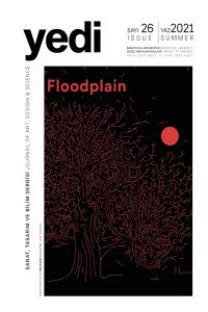Filmlerle Tarih Yazmak: İstanbul’un Fethi Örneği
Tarihi film, tarih yazımı, temsil, politik İslam, Osmanlı Devleti.
Writing History With Films: A Comparative Analysis of Films About the Conquest of İstanbul
Historical film, historiography, representation, political Islam, Ottoman State Tarihi film, tarih yazımı, temsil, politik İslam, Osmanlı Devleti.,
___
- Akman, Ş. T. (2011). Türk tarih tezi bağlamında erken Cumhuriyet dönemi resmi tarih yazımının ideolojik ve politik karakteri. Hacettepe Hukuk Fakültesi Dergisi, 1 (1), 80-89.
- Aksoy, F. (2012, May 7). Ben rakam vermedim. Pınar Yılmazer ropörtajı. Hürriyet Kelebek. https://www.hurriyet.com.tr/kelebek/ben-rakam-vermedim-20068234
- Bağır, M. (2016). Türk sinemasında tarihi film olgusu (Thesis No. 428236). [Published Master Thesis, Atatürk University], National Thesis Center.
- Balcı, D. (2013) Yeşilçam’da öteki olmak. Kolektif Kitap.
- Behar, B. E. (1996). İktidar ve tarih: Türkiye’de resmi tarih tezinin oluşumu (1929- 1937). Afa Yayınları.
- Carney, J. (2014). Re-creating history and recreating publics: the success and failure of recent Ottoman costume dramas in Turkish media. European Journal of Turkish Studies, 19. https://doi.org/10.4000/ejts.5050.
- Carr, E.H. (1990). What is history? Penguin Books.
- Collingwood, R. G. (1990). Tarih tasarımı (K. Dinçer, Çev.). Ara Yayıncılık.
- Desphande, A. (2004). Film as historical sources or alternative history. Economic and Political Weekly, 39(40), 44-55.
- Ferro, M. (1995). Sinema ve tarih (T. Ilgaz ve H. Tufan, Çev.). Kesit Yayınları.
- Ferro, M. (2003). The use and abuse of history. Routledge.
- McMahon, N. (2017). A contentious genre: defining the historical film. The Asian Conference On Media, Communication & Film Official Conference Proceedings. https://papers.iafor.org/submission36982/
- Ormanlı, O. (2006). Türk sinemasında geçiş dönemi (1939-1950). Sinematürk Dergisi (1), 28-30.
- Özen, S. (2020). Sinematografta İstanbul’un fethi sinema salonunda tarih yapımı. Toplumsal Tarih (318).
- Salmi, H. (1995). Film as historical narrative. Film Historia, 5 (1), 45-54. http://ecourse.uoi.gr/pluginfile.php/95693/mod_resource/content/1/Art.Salmi.pdf.
- Şatana, N., S. Yücesoy. (2018). Türk sinemasında gelişen yapımcılık modelleri bağlamında günümüz yapımcılığının derinlemesine analizi. Adnan Menderes Üniversitesi Dördüncü Kuvvet Uluslararası Hakemli Dergisi, 1(2), 95-115.
- Schwarts, V. R. (2013). Film and history. Histoire@Politique, 19, 176-198.
- Soydan, M. (2008). Postyapısalcı bir okumayla eurimages destekli Türk filmlerinin çözümlenmesi (Thesis No. 230983).[Puslished PhD Thesis, Ege University], National Thesis Center.
- Stubbs, J. (2013). Historical film: A critical introduction. Bloomsbury Academic.
- Tamdoğan, I. (2015, May 29). Fetih kutlamaları milliyetçi-islami kimliği oluşturmanın önemli bir malzemesi- E. C. Dağlıoğlu ropörtajı”. Agos. https://www.agos.com.tr/tr/yazi/11729/fetih-kutlamalari-milliyetci-islami-kimligi-olusturmanin-onemli-bir-malzemesi
- Tekeli, İ. (1998). Tarih yazımı üzerine düşünmek. Dost Yayınları.
- Traverso, E. (2011). Savaş alanı olarak tarih. Ayrıntı Yayınları.
- White, H. (2000). An old question raised again: is historiography art or science? (Response to Iggers). Rethinking History, 4(3), 391-406.
- Yaşlı, F. (2014). AKP, cemaat, sünni ulus: Yeni Türkiye üzerine tezler. Yordam Kitap.
- Yılmazok, L. (2010). Turkish films co-produced within Europe: the story after twenty years’ experience in eurimages. Sinecine, 1(2), 87-108.
- Zürcher, E. J. (2006). Modernleşen Türkiye’nin tarihi. İletişim Yayınları.
- ISSN: 1307-9840
- Başlangıç: 2007
- Yayıncı: Dokuz Eylül Üniversitesi
Filmlerle Tarih Yazmak: İstanbul’un Fethi Örneği
Devam Oyunlarında Alımlama: Tarla Kuşuydu Juliet, Nina ve Nora 2
Kieslowski’nin Dekalog II Filminin Varoluşsal Kaygı Çerçevesinde Felsefi Eleştirisi
Emir Kusturica Filmlerinde Büyülü Gerçekçilik
Harç Yığma Tekniğiyle Çalışan Seramik Yazıcılarda Kullanılabilecek Eritici Katkılı Bünye Tasarımları
Efe TÜRKEL, Pınar ÇALIŞKAN GÜNEŞ
Sürdürülebilir Tekstiller Kapsamında Evsel Organik Atıklarla Bojagi-Jogakbo’nun Yeniden Yorumlanması
Yörüklerde Müzik ve Boğaz Çalma
Sinemada Mekân: The Fall Filmi’nde Göstergebilimsel Yaklaşımla Mekân Okumaları
Filiz ÇELİK, Begüm Dilara ARSLAN, Fikriye YILDIZ, Merve KALP
MÜZE VE TOPLUM İLİŞKİLERİNDE EĞİTİM, SOSYAL HAREKET VE KATILIMIN YENİ BOYUTLARI
360 Fotoğraf Tasarımında Aksiyon Kamerası ve Post Manzara Anlayışı Üzerine Analizler
